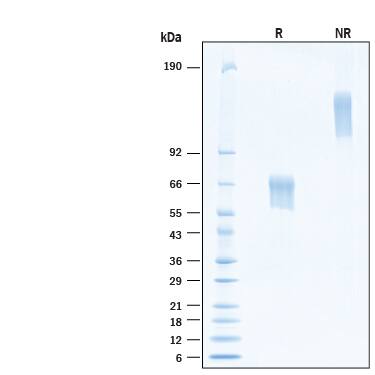Recombinant Human CD27/TNFRSF7 Fc Avi-tag Protein, CF
R&D Systems, part of Bio-Techne | Catalog # AVI11027
Biotinylated

Key Product Details
Learn more about Avi-tag Biotinylated Proteins
Source
CHO
Accession #
Structure / Form
Disulfide-linked
homodimer
Biotinylated via Avi-tag
Biotinylated via Avi-tag
Conjugate
Biotin
Applications
Bioactivity
Product Specifications
Source
Chinese Hamster Ovary cell line, CHO-derived human CD27/TNFRSF7 protein
| Human CD27 (Thr21-Arg191) Accession # P26842.2 |
IEGRMD | Human IgG1 Fc (Pro100-Lys330) |
Avi-tag |
| N-terminus | C-terminus | ||
Purity
>95%, by SDS-PAGE visualized with Silver Staining and quantitative densitometry by Coomassie® Blue Staining.
Endotoxin Level
<0.10 EU per 1 μg of the protein by the LAL method.
N-terminal Sequence Analysis
Thr21
Predicted Molecular Mass
48 kDa
SDS-PAGE
57-69 kDa, under reducing conditions.
Activity
Measured by its binding ability in a functional ELISA.
When Recombinant Human CD27 Ligand/TNFSF7 Protein (Catalog # 9328-CL) is immobilized at 1.0 µg/mL (100 µL/well), Biotinylated Recombinant Human CD27/TNFRSF7 Fc Chimera Avi-tag (Catalog # AVI11027) binds with an ED50 of 6.00-60.0 ng/mL.
When Recombinant Human CD27 Ligand/TNFSF7 Protein (Catalog # 9328-CL) is immobilized at 1.0 µg/mL (100 µL/well), Biotinylated Recombinant Human CD27/TNFRSF7 Fc Chimera Avi-tag (Catalog # AVI11027) binds with an ED50 of 6.00-60.0 ng/mL.
Scientific Data Images for Recombinant Human CD27/TNFRSF7 Fc Avi-tag Protein, CF
Biotinylated Recombinant Human CD27/TNFRSF7 Fc Chimera Avi-tag Protein SDS-PAGE.
2 μg/lane of Biotinylated Recombinant Human CD27/TNFRSF7 Fc Chimera Avi-tag Protein (Catalog # AVI11027) was resolved with SDS-PAGE under reducing (R) and non-reducing (NR) conditions and visualized by Coomassie® Blue staining, showing bands at 57-69 kDa and 110-140 kDa, respectively.Formulation, Preparation and Storage
AVI11027
| Formulation | Lyophilized from a 0.2 μm filtered solution in PBS with Trehalose. |
| Reconstitution | Reconstitute at 500 μg/mL in PBS. |
| Shipping | The product is shipped at ambient temperature. Upon receipt, store it immediately at the temperature recommended below. |
| Stability & Storage | Use a manual defrost freezer and avoid repeated freeze-thaw cycles.
|
Background: CD27/TNFRSF7
References
- Nolte, M.A. et al. (2009) Immunol. Rev. 229:216.
- Camerini, D. et al. (1991) J. Immunol. 147:3165.
- van Lier, R.A. et al. (1987) J. Immunol. 139:1589.
- Loenen, W.A. et al. (1992) Eur. J. Immunol. 22:447.
- Takeda, K. et al. (2000) J. Immunol. 164:1741.
- Xiao, Y. et al. (2004) J. Immunol. 172:7432.
- Jung, J. et al. (2000) Eur. J. Immunol. 30:2437.
- Goodwin, R.G. et al. (1993) Cell 73:447.
- Bowman, M.R. et al. (1994) J. Immunol. 152:1756.
- Hendriks, J. et al. (2000) Nat. Immunol. 1:433.
- van Oosterwijk, M.F. et al. (2007) Int. Immunol. 19:713.
- Rowley, T.F. and A. Al Shamkhani (2004) J. Immunol. 172:6039.
- Hendriks, J. et al. (2003) J. Exp. Med. 198:1369.
- Kelly, J.M. et al. (2002) Nat. Immunol. 3:83.
- Raman, V.S. et al. (2003) J. Immunol. 171:5876.
Alternate Names
CD27, TNFRSF7
Gene Symbol
CD27
UniProt
Additional CD27/TNFRSF7 Products
Product Documents for Recombinant Human CD27/TNFRSF7 Fc Avi-tag Protein, CF
Product Specific Notices for Recombinant Human CD27/TNFRSF7 Fc Avi-tag Protein, CF
For research use only
